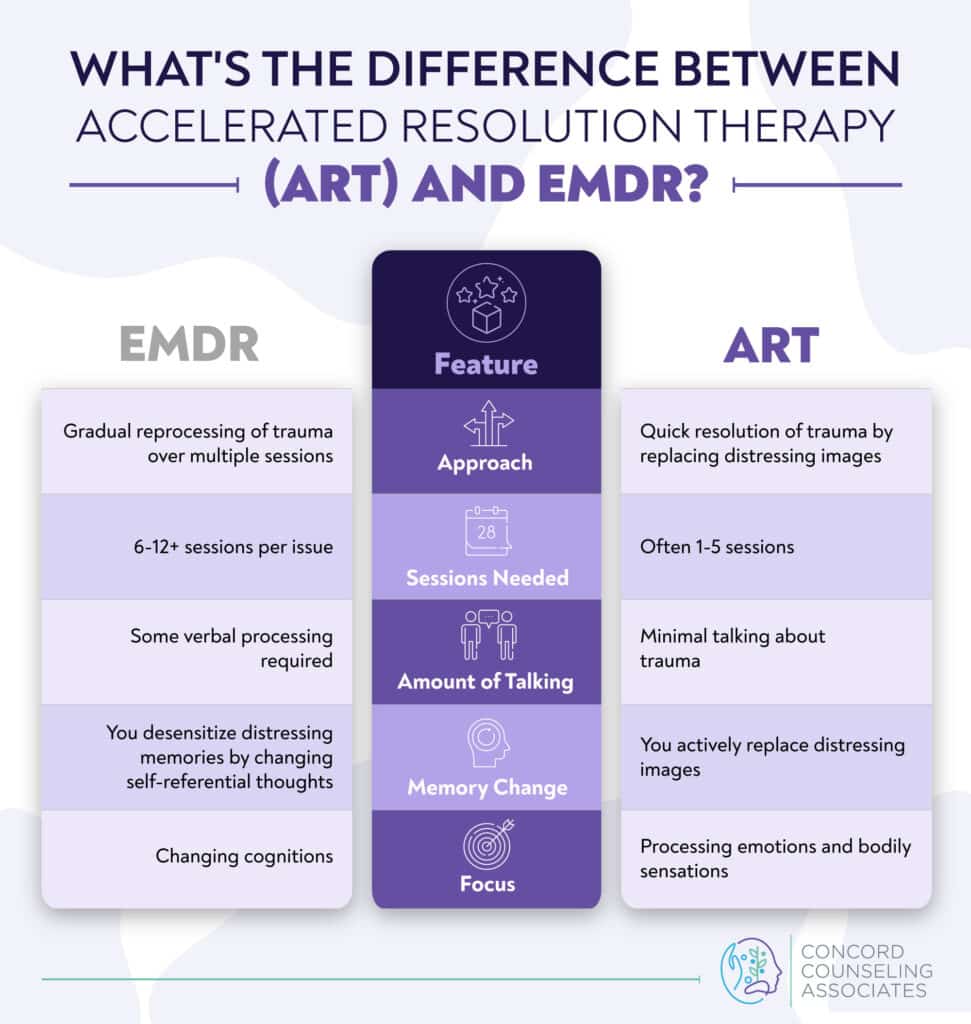Both Accelerated Resolution Therapy (ART) and Eye Movement Desensitization and Reprocessing (EMDR) are evidence-based therapeutic techniques that are used to treat trauma and other mental health conditions. Specifically, both EMDR and ART aim to help “take the sting” out of traumatic memories by replacing the feeling of being triggered by the memory with a feeling of safety. In polyvagal terms, both therapies help replace the sympathetic activation related to a traumatic memory with a ventral vagal response. In this post, I’ll highlight the key differences between ART and EMDR.





What is EMDR?
EMDR is a therapy that uses bilateral stimulation while recalling a traumatic or stressful event. Bilateral stimulation includes side-to-side eye movements or alternating tactile stimulation using devices called “buzzers” or “tappers” that are held in each hand. While alternating auditory bilateral stimulation has been used in EMDR, there is evidence that auditory stimulation is ineffective in memory retrieval, a necessary component of EMDR.
A typical EMDR session includes:
1) identifying the memory, emotions, and negative belief about self linked to the traumatic event;
2) Using bilateral stimulation to reduce the emotional charge of the memory;
3) Replacing the negative belief about self with a positive belief; and
4) Removing any lingering discomfort held in the body
What is ART?
ART also uses bilateral stimulation while recalling a traumatic event. While tactile stimulation can be used in ART, it is only to be used if a person cannot engage in eye movements. In ART, the client is asked to visualize the traumatic event as a movie while engaging in eye movements. The client is later asked to create a positive “movie” that will replace the traumatic one. Even though a positive event replaces the negative one, the client still maintains all of the factual information about the original traumatic event. Like EMDR, ART focuses on helping reduce the charge (or what I call the “sting”) of the original memory.
A typical ART session includes:
1) Identifying the memory and recalling the images like a movie;
2) Using bilateral stimulation to reduce the emotional charge of the memory;
3) Processing bodily sensations and emotions;
4) Replacing the negative movie with a positive one
Key differences between ART and EMDR
- Sessions needed: ART is faster at processing traumatic memories than EMDR. The same amount of processing accomplished in a single 90-minute ART session would take the equivalent of 6-8 EMDR sessions.
- Resolution of presenting issue: ART can work in as little as one session depending on the nature of the issue, it also allows for a completion of processing within the session. Alternatively, with EMDR, we expect that processing will continue with additional material often emerging between sessions.
- Use of metaphors and imagery: ART relies more heavily on the use of metaphors and imagery in order to guide the client to resolving their issue. ART calls upon the client’s creativity engaged through imagery to help solve the presenting issue whereas EMDR follows a more literal approach to solving the problem.
- Focus on emotions, sensations, and cognitions: EMDR primarily focuses on changing cognitions– generally how a person feels about themselves because of a traumatic event while ART focuses on processing the emotions and bodily sensations that come up because of visualizing a traumatic event.
- Habit change: ART has specific protocols to help with habit change. This can be as broad as wanting to be a better partner or as specific as incorporating more exercise into your daily routine. ART is also effective at helping people overcome creative blocks.
- Treatment structure: Both ART and EMDR have structured protocols for treatment; however, the goal of the ART protocol is to resolve processing of the issue within a single session. In other words, the client is generally not triggered at the end of an ART session. EMDR processing can continue right up until the end of the session and sometimes in between sessions. EMDR more often uses metaphorical “containers” for emotions and sensations that are still bothering the client at the end of the session. While these “containers” may also used in ART, they are rarely needed at the end of a session.
Which Therapy is Right for Me?
The choice between EMDR and ART depends on personal needs and preferences. It’s important to consult with a licensed mental health professional to determine which one is best for you. The most effective direction can be provided by someone who is trained in both EMDR and ART. Typically, one chooses ART over EMDR when:
- You want faster symptom relief.
- You prefer a method where you don’t want to talk about painful memories.
- You like the idea of “replacing” traumatic imagery rather than focusing on thoughts about it.
- You want to feel better quickly without extensive emotional deep-diving.
Conclusion
Both ART and EMDR are evidence-based treatments for trauma and other mental health issues. While both use bilateral stimulation to help desensitize and reprocess traumatic memories, they go about it in different ways. ART focuses on replacing traumatic images with more positive ones. The person maintains the facts and knowledge of the original event while not having the original fight or flight response. EMDR, on the other hand, focuses on replacing traumatic cognitions like “I’m not a good person” with more positive ones. ART often works in fewer sessions, with little to no talking about the traumatic event, and focuses on processing emotions and bodily sensations. The best way to see which one is right for you is to consult with a licensed mental health professional to help diagnose your symptoms and recommend an appropriate course of action. You can find trained Accelerated Resolution Therapists here and trained EMDR therapists here.
